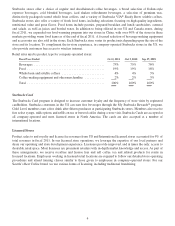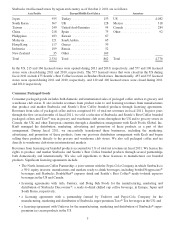Starbucks 2011 Annual Report Download - page 18
Download and view the complete annual report
Please find page 18 of the 2011 Starbucks annual report below. You can navigate through the pages in the report by either clicking on the pages listed below, or by using the keyword search tool below to find specific information within the annual report.embrace our products to the same extent as consumers in our US market or other international markets. Occupancy
costs and store operating expenses can be higher internationally than in the US due to higher rents for prime store
locations or costs of compliance with country-specific regulatory requirements. Because many of our international
operations are in an early phase of development, operating expenses as a percentage of related revenues are often
higher compared to US operations. Additionally, our international joint venture partners or licensees may face
capital constraints or other factors that may limit the speed at which they are able to expand and develop in a certain
market.
Our international operations are also subject to additional inherent risks of conducting business abroad, such as:
• foreign currency exchange rate fluctuations;
• changes or uncertainties in economic, legal, regulatory, social and political conditions in our markets;
• interpretation and application of laws and regulations;
• restrictive actions of foreign or US governmental authorities affecting trade and foreign investment,
including protective measures such as export and customs duties and tariffs, government intervention
favoring local competitors, and restrictions on the level of foreign ownership;
• import or other business licensing requirements;
• the enforceability of intellectual property and contract rights;
• limitations on the repatriation of funds and foreign currency exchange restrictions due to current or new US
and international regulations;
• in developing economies, the growth rate in the portion of the population achieving targeted levels of
disposable income may not be as fast as we forecast;
• difficulty in staffing, developing and managing foreign operations and supply chain logistics, including
ensuring the consistency of product quality and service, due to distance, language and cultural differences;
• local laws that make it more expensive and complex to negotiate with, retain or terminate employees; and
• delays in store openings for reasons beyond our control, competition with locally relevant competitors or a
lack of desirable real estate locations available for lease at reasonable rates, any of which could keep us from
meeting annual store opening targets and, in turn, negatively impact net revenues, operating income and
earnings per share.
Moreover, many of the foregoing risks are particularly acute in developing countries, which are important to our
long-term growth prospects.
•Increases in the cost of high-quality arabica coffee beans or other commodities or decreases in the availability
of high quality arabica coffee beans or other commodities could have an adverse impact on our business and
financial results.
We purchase, roast, and sell high-quality whole bean arabica coffee beans and related coffee products. The price of
coffee is subject to significant volatility and, over the last two years, the base “C” coffee commodity price has
increased markedly. The high-quality arabica coffee of the quality we seek tends to trade on a negotiated basis at a
premium above the “C” price. This premium depends upon the supply and demand at the time of purchase and the
amount of the premium can vary significantly. Increases in the “C” coffee commodity price do increase the price of
high-quality arabica coffee and also impact our ability to enter into fixed-price purchase commitments. The supply
and price of coffee we purchase can also be affected by multiple factors in the producing countries, including
weather, natural disasters and political and economic conditions, as well as the actions of certain organizations and
associations that have historically attempted to influence prices of green coffee through agreements establishing
export quotas or by restricting coffee supplies. Speculative trading in coffee commodities can also influence coffee
prices. Because of the significance of coffee beans to our operations, combined with our ability to only partially
12
























